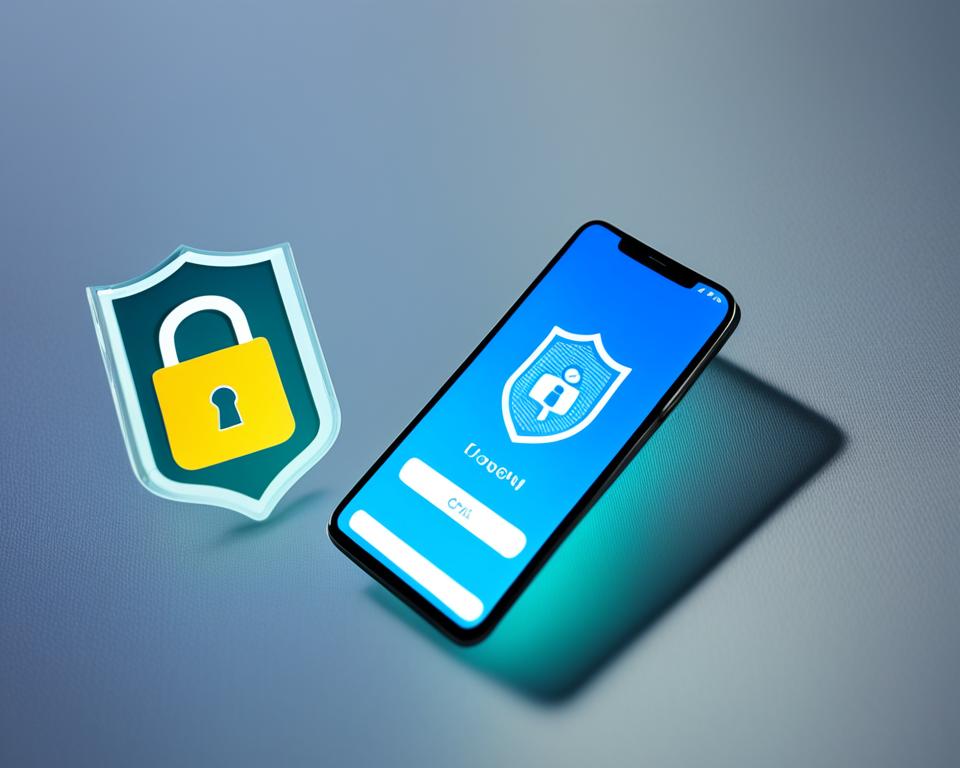Welcome to the essential guide to mobile banking security. With the increasing popularity of mobile banking, it is crucial to prioritize the security of your financial information. In this guide, we will provide you with valuable information on how to protect your finances and ensure a secure mobile banking experience.
Mobile banking has revolutionized the way we manage our finances, offering convenience and flexibility. Through mobile banking apps and online banking services, you can easily access your accounts, make transactions, and monitor your balances anytime, anywhere.
However, as with any online activity, there are potential security risks associated with mobile banking. It is essential to understand these risks and take necessary precautions to safeguard your financial information from cyber threats.
Key Takeaways:
- Mobile banking offers convenience and flexibility for managing your finances.
- Prioritizing the security of your mobile banking app is crucial to protect your financial information.
- Understanding the potential risks and taking necessary precautions can help safeguard your accounts from cyber threats.
- Choose trusted sources for downloading mobile banking apps and ensure your bank uses secure authentication methods.
- Regularly monitor your accounts and transactions for any suspicious activity.
Is Mobile Banking Safe?
Mobile banking has revolutionized the way we manage our finances, providing convenience and accessibility on the go. However, with the increasing use of mobile banking comes concerns about security. It is crucial to understand the potential risks and take necessary precautions to ensure the safety of your financial information.
When it comes to mobile banking security, one of the key recommendations from cybersecurity experts is to download mobile banking apps only from secure sources. Stick to trusted channels, such as your bank’s official website or legitimate app marketplaces, to minimize the risk of cyberattacks.
There are two common types of cyberattacks in mobile banking that users should be aware of. The first is app-based banking Trojans, which are often hidden within unrelated apps. These Trojans create pop-up overlays that mimic a bank’s login page, tricking users into entering their credentials. The second is fake banking apps, which can closely resemble legitimate banking apps and aim to deceive users into disclosing their login information.
“Downloading mobile banking apps only from secure sources, such as your bank’s official website, can help protect you from app-based banking Trojans and fake banking apps.”
To illustrate the importance of mobile banking safety, here is a relevant statistic:
| Type of Cyberattack | Frequency |
|---|---|
| App-based Banking Trojans | Increased by 50% in the past year |
| Fake Banking Apps | Over 1,000 fake banking apps detected |
Protecting Yourself from Mobile Banking Fraud
As a mobile banking user, it is essential to take appropriate measures to protect yourself from mobile banking fraud. Here are some actionable steps you can follow:
- Download mobile banking apps only from trusted sources, such as your bank’s official website or legitimate app marketplaces.
- Regularly update your mobile banking app to ensure that you have the latest security patches.
- Enable two-factor or multi-factor authentication for an additional layer of security.
- Create a strong and unique password for your mobile banking app, using a combination of uppercase and lowercase letters, numbers, and symbols.
- Avoid using public Wi-Fi networks for financial transactions, as they may be vulnerable to hackers.
- Be cautious of phishing attempts and never share your login credentials or personal information in response to unsolicited messages or emails.
By following these precautions and staying vigilant, you can significantly reduce the risk of falling victim to mobile banking fraud.
Types of Cyberattacks in Mobile Banking
When it comes to mobile banking, it’s essential to be aware of the potential cyber threats that can compromise the security of your financial information. Two common types of cyberattacks in mobile banking are app-based banking Trojans and fake banking apps.
App-Based Banking Trojans:
App-based banking Trojans are malicious software programs that are often hidden within seemingly unrelated apps. These Trojans can be downloaded from unofficial sources, such as third-party websites or app marketplaces. Once installed on a user’s device, they create pop-up overlays that mimic a bank’s login page.
The aim of these Trojans is to trick users into entering their login credentials, which are then captured by cybercriminals. The unsuspecting users may believe they are logging in to their legitimate mobile banking app, but in reality, their information is being stolen by malicious actors.
Fake Banking Apps:
Fake banking apps are specifically designed to mimic legitimate mobile banking apps. These fraudulent apps are created by cybercriminals and are often available for download from unofficial sources. Once installed, fake banking apps trick users into entering their login credentials, which are then captured by the criminals.
These apps may appear similar to the official banking app, with similar logos, features, and interfaces, making it difficult for users to differentiate between the real and fake versions. It is crucial to be cautious and verify the authenticity of the mobile banking app before entering any sensitive information.
| Types of Cyberattacks | Key Characteristics |
|---|---|
| App-based banking Trojans | Hidden within unrelated apps |
| Create pop-up overlays to mimic bank’s login page | |
| Trick users into entering credentials | |
| Downloaded from unofficial sources | |
| Can compromise login credentials | |
| Risks personal and financial information | |
| Fake banking apps | Impersonate legitimate mobile banking apps |
| Crafted by cybercriminals | |
| Designed to steal login credentials | |
| Susceptible to unofficial sources | |
| Difficult to differentiate from real apps |
These types of cyberattacks can pose serious risks to your personal and financial information. It is crucial to take necessary precautions to protect yourself while using mobile banking apps.
Next, we will explore the precautions you can take to enhance the security of your mobile banking experience and protect yourself against these cyber threats.
Precautions for Using Mobile Banking Apps
To ensure the security of your mobile banking experience, it is important to take certain precautions. By following these measures, you can enhance the security of your mobile banking app:
- Download apps from trusted sources: Only download mobile banking apps from secure and trusted sources, such as your bank’s official website or a valid app marketplace.
- Use verified banking apps: Use mobile banking apps that have been recommended and verified by your bank. Avoid downloading unknown or unofficial apps.
- Enable two-factor authentication: Make sure your bank’s mobile banking app requires two-factor or multi-factor authentication for login. This provides an extra layer of security by requiring an additional verification step.
- Create strong passwords: Use unique, complex passwords that include a combination of uppercase and lowercase letters, numbers, and special characters. Avoid using easily guessable passwords or using the same password for multiple accounts.
- Avoid public Wi-Fi networks: When accessing your mobile banking app, avoid using public Wi-Fi networks as they may not be secure. Instead, use a trusted and secure internet connection, such as your personal mobile data or a secure Wi-Fi network.
- Be cautious of phishing and smishing attempts: Be vigilant of any suspicious emails, text messages, or calls requesting personal or financial information. Avoid clicking on suspicious links or providing sensitive information to unknown sources.
By following these precautions, you can mitigate the risks associated with mobile banking app security and ensure a safer banking experience on your mobile device.
Protecting Yourself Against Mobile Banking Fraud
To ensure the safety of your mobile banking experience and protect yourself against mobile banking fraud, it is important to take certain precautions. By following these mobile banking security tips, you can reduce the risk of falling victim to fraudulent activities.
- Download from official sources: Always download the mobile banking app from your bank’s official website. Avoid downloading apps from third-party or unofficial sources.
- Enable two-factor authentication: Opt for two-factor or multi-factor authentication to add an extra layer of security when logging in to your mobile banking account. This ensures that even if your password is compromised, an additional code or verification process is required to access your account.
- Create a strong password: Use a unique and strong password for your mobile banking app. Include a combination of numbers, symbols, uppercase and lowercase letters to make it harder for hackers to guess.
- Avoid public Wi-Fi networks: When conducting financial transactions through your mobile banking app, avoid using public Wi-Fi networks. These networks are often unsecure, making it easier for hackers to intercept your data.
- Be cautious of phishing and smishing attempts: Phishing and smishing are common methods used by fraudsters to trick users into revealing their personal and financial information. Be vigilant of suspicious emails, text messages, or phone calls asking for sensitive information. Verify the authenticity of any communication with your bank directly.
- Monitor your accounts: Regularly review your mobile banking app and bank statements for any suspicious activity. Report any unauthorized transactions to your bank immediately.
By implementing these mobile banking security measures, you can significantly reduce the risk of mobile banking fraud and protect your finances.
Note: The image above highlights the importance of mobile banking fraud prevention.
How Banks Protect Customers from Cyber Threats
Banks are committed to safeguarding their customers’ financial information and have implemented robust cybersecurity measures to protect against cyber threats. These measures encompass various mobile banking security practices and technologies aimed at ensuring secure transactions and preventing unauthorized access.
Mobile Banking Security Measures
Banks utilize advanced encryption technologies to secure customer data during transmission and storage. This ensures that sensitive information, such as account details and transaction history, remains confidential and protected from interception by malicious actors.
Additionally, financial institutions have implemented stringent guidelines to ensure the security of their mobile banking apps. Regular audits are conducted to identify and patch any vulnerabilities that could potentially be exploited by cybercriminals.
“Banks invest heavily in cybersecurity measures to protect their customers from cyber threats.”
Moreover, banks may employ multi-factor authentication methods to add an extra layer of security. By requiring customers to provide additional forms of verification, such as a unique code or biometric data, banks can ensure that only authorized individuals can access their mobile banking services.
Bank Cybersecurity Practices
Banks take cybersecurity seriously and have established comprehensive practices to protect against cyber threats. These practices include:
- Ongoing monitoring of employees’ behavior to detect any unusual activity or signs of internal threats.
- Implementation of strict access controls, limiting employee access to sensitive systems and data on a need-to-know basis.
- Regular employee training and education programs to raise awareness of cybersecurity best practices and potential threats.
- Collaboration with cybersecurity experts to stay updated on the latest security trends and technologies.
- Continuous monitoring and analysis of network traffic for detecting and mitigating potential security incidents.
Financial institutions also employ fraud detection systems that analyze customer transactions for suspicious activity. These systems can trigger alerts for unusual behaviors such as large transfers or transactions in unfamiliar locations.
Bank Cybersecurity Practices
| Bank Cybersecurity Practices | Description |
|---|---|
| Ongoing employee monitoring | Regular monitoring of employees’ behavior to detect any signs of internal threats or unusual activity. |
| Strict access controls | Limiting employee access to sensitive systems and data on a need-to-know basis. |
| Employee training and education | Providing regular training programs to educate employees on cybersecurity best practices and potential threats. |
| Collaboration with experts | Working with cybersecurity experts to stay updated on the latest security trends and technologies. |
| Network traffic monitoring | Continuously monitoring and analyzing network traffic to detect and mitigate potential security incidents. |
| Fraud detection systems | Utilizing systems that analyze customer transactions for suspicious activities and trigger alerts for unusual behaviors. |
By employing these mobile banking security measures and practicing robust bank cybersecurity practices, financial institutions strive to provide their customers with a secure mobile banking experience. Protecting customer data and ensuring the integrity of transactions is of paramount importance, and banks continuously invest in improving their security measures to counter evolving cyber threats.
Tips for Online and Mobile Banking Users
As an online and mobile banking user, there are several tips you can follow to enhance your security. By implementing these precautions, you can protect your financial information and have peace of mind while conducting your banking activities.
- Use strong and unique passwords: It is crucial to create strong and unique passwords for each of your online and mobile banking accounts. Avoid using common phrases or personal information that can be easily guessed. Additionally, refrain from sharing your passwords with anyone, even family or friends.
- Ensure a secure internet connection: When accessing your online or mobile banking accounts, always use a secure and trusted internet connection. Avoid using public Wi-Fi networks, as they can be vulnerable to hackers who may intercept your data.
- Verify communication authenticity: Be cautious of any communication you receive from your financial institution. Ensure the authenticity of emails, text messages, or phone calls by directly contacting your bank’s official customer service line through verified contact information. This will help you avoid falling victim to phishing attempts or scams.
- Download from trusted sources: Only download mobile banking apps from trusted sources such as your bank’s official website or legitimate app marketplaces. Avoid third-party or unauthorized sources, as they may contain malicious software or fraudulent apps intended to steal your personal information.
- Regularly monitor your accounts: Stay vigilant and monitor your online and mobile banking accounts regularly. Check your transaction history and account balances to identify any unauthorized activity. If you notice any suspicious transactions, report them to your financial institution immediately.
- Log out after each session: Always remember to log out of your online and mobile banking accounts after each session. This will help prevent unauthorized access to your account, especially if you are using a shared or public device.
- Keep your software up to date: Ensure that your devices have the latest security updates and patches installed. Regularly update your anti-malware and antivirus software to protect against emerging threats and vulnerabilities.
By following these online banking security tips and mobile banking security tips, you can significantly reduce the risk of unauthorized access and protect your financial information.
Importance of Customer Education in Mobile Banking Security
Customer education plays a vital role in ensuring mobile banking security. Financial institutions should prioritize educating their customers about the potential risks and precautions associated with mobile banking. By raising awareness and providing ongoing education, banks can empower their customers to make informed decisions and take necessary steps to protect their financial information.
One of the key areas that require customer education is the importance of using two-factor or multi-factor authentication. By encouraging customers to enable this extra layer of security, banks can significantly reduce the risk of unauthorized access to their accounts. Additionally, financial institutions should provide clear guidelines on secure internet connections, emphasizing the importance of using private and trusted networks for mobile banking transactions.
Another crucial aspect of customer education is highlighting the significance of strong passwords. Banks should educate their customers about creating unique and complex passwords that are not easily guessable. Emphasizing the importance of combining letters, numbers, and special characters can help customers safeguard their mobile banking accounts.
By providing comprehensive customer education, financial institutions can foster a sense of security and trust among their customers. Educated customers are more likely to proactively implement security measures and promptly report any suspicious activities, contributing to a safer mobile banking environment overall.
Benefits of Customer Education in Mobile Banking Security:
- Empowers customers to protect their financial information
- Reduces the risk of unauthorized access to accounts
- Promotes the use of secure internet connections
- Enhances the importance of strong passwords
- Fosters a sense of security and trust
“An educated customer is an empowered customer.”
Financial institutions should consider implementing educational programs and resources, such as online tutorials, webinars, and informative articles, to ensure their customers are well-informed about mobile banking security best practices.
| Customer Education in Mobile Banking Security | Benefits |
|---|---|
| Promotes awareness of mobile banking risks | Helps customers make informed decisions |
| Encourages the use of two-factor or multi-factor authentication | Increases account security |
| Provides guidelines on secure internet connections | Reduces the risk of data breaches |
| Emphasizes the importance of strong passwords | Minimizes the likelihood of unauthorized access |
By prioritizing customer education in mobile banking security, financial institutions can work towards creating a safer and more secure mobile banking experience for their customers.

Conclusion
Mobile banking has revolutionized the way we manage our finances, providing us with convenience and flexibility. However, ensuring the security of your mobile banking experience is of utmost importance to protect your financial information from cyber threats.
By following the recommended precautions, such as downloading mobile banking apps only from trusted sources and using strong passwords, you can significantly reduce the risk of unauthorized access to your accounts.
Financial institutions also play a crucial role in ensuring mobile banking security. They employ robust security measures, such as high-end encryption technologies and regular monitoring, to protect their customers from cyber threats. These measures aim to provide a safe and secure mobile banking environment.
By staying informed about potential risks and taking necessary steps to protect yourself, you can enjoy the convenience of mobile banking while keeping your finances secure. Remember to stay vigilant, follow best practices, and monitor your accounts regularly to detect any suspicious activity. With these precautions in place, you can confidently embrace the benefits of mobile banking while safeguarding your financial well-being.
FAQ
Is mobile banking safe?
Mobile banking is generally considered safe, but it is important to take certain precautions to ensure the security of your financial information.
What are the types of cyberattacks in mobile banking?
Two common types of cyberattacks in mobile banking are app-based banking Trojans and fake banking apps.
What precautions should I take when using mobile banking apps?
To ensure the security of your mobile banking experience, it is important to download mobile banking apps only from trusted sources, such as your bank’s official website or a valid app marketplace.
How can I protect myself against mobile banking fraud?
You can protect yourself against mobile banking fraud by downloading the mobile banking app from your bank’s official website, enabling two-factor or multi-factor authentication, using a strong and unique password, avoiding public Wi-Fi networks, and being cautious of phishing and smishing attempts.
How do banks protect customers from cyber threats?
Banks invest heavily in cybersecurity measures to protect their customers from cyber threats. They use high-end encryption technologies, monitor employee behavior, regularly patch vulnerabilities, and offer features like alerts for suspicious transactions and fraud detection.
What tips should online and mobile banking users follow for enhanced security?
Online and mobile banking users should use strong and unique passwords, ensure they are using a secure internet connection, verify the authenticity of any communication they receive from their financial institution, download mobile banking apps only from trusted sources, regularly monitor their accounts and transactions, and keep their anti-malware and antivirus software up to date.
How important is customer education in mobile banking security?
Customer education plays a vital role in ensuring mobile banking security. Financial institutions should educate their customers about potential risks and precautions, such as two-factor or multi-factor authentication, secure internet connections, and the importance of strong passwords.
What is the summary of mobile banking security?
Mobile banking offers convenience and flexibility, but it is important to prioritize security to protect your financial information. By following recommended precautions and staying informed about mobile banking security, you can have a safe and secure mobile banking experience.





